Is today’s market for remanufactured rack-and-pinion
steering units meandering through the doldrums of a mature aftermarket,
or is it heading in a new direction that may soon create new opportunities
for rebuilders?
Some say the worst is behind them. They say
rack prices have bottomed out, competition has leveled off, and
a growing number of retailers have come to realize that quality
is just as important as price. Nobody is betting the farm on a
resurgence in demand for rebuilt racks because OEM racks have
become more durable and longer-lived in recent years. But those
who have weathered the "rack wars" say there’s light
at the end of the tunnel and it isn’t the headlight of an oncoming
freight train.
The optimists see emerging opportunities in
import racks, high-tech racks (those with variable rate assist),
and growth in the use of racks on sport utility vehicles (SUVs).
A little further out, they see a whole new generation of electro-hydraulic
and fully electronic steering racks coming that may revolutionize
the rack rebuilding business as we know it today.
Others are less optimistic about the current
and future state of the industry. Some say there may yet be another
round of ratcheting down on rack prices before the dust settles.
They bemoan the slim profit margins in today’s market, the cutthroat
pricing between rebuilders, the ongoing proliferation of part
numbers (especially in import racks), the sacrifice of quality
for the sake of pricing, and the fact that OEM racks are not wearing
out as quickly as they once did. A rack that might have lasted
only 60,000 to 80,000 miles a few years ago may now last 100,000
to 120,000 miles.
And the forecast for the long term? The pessimists
see little opportunity in rebuilding electronic racks because
such racks won’t appear in significant numbers until well beyond
the year 2000 because of their initial cost disadvantage compared
to hydraulic units. They say when hydraulic racks are gone, so
will be the main reason for replacing steering racks, i.e., fluid
leaks. Electronic racks won’t necessarily have any fluid to leak
so unless there’s an electronic failure they won’t need to be
replaced.
So which view is right? Is the power steering
reservoir half full or half empty? The answer depends on where
you find yourself in today’s market.
Market forces
With opinions about today’s rack market ranging
from "cruddy" to "cautiously optimistic,"
the concerns voiced by those we interviewed are typical for those
who find themselves in a mature aftermarket. When competition
gets tough and there’s a squeeze on prices, economic forces favor
the lowest cost suppliers. Attrition and consolidation weeds out
the less efficient. Those who are left are smarter, more cost
efficient, and better able to meet the demands of an ever-changing
marketplace.
Most agree that it takes a significantly larger
investment in equipment and inventory to rebuild racks profitably
today than it did in the past. It used to be a rebuilder could
cover most of the popular applications with about 30 part numbers.
Today is takes at least 70, and as many as 300 or more if you’re
talking complete coverage of both import and domestic applications.
Consequently, many say current market conditions favor the big
rebuilders who can afford the investment it takes to be a full-line
supplier of rebuilt racks.
Even so, many small shops continue to compete
aggressively at the local level in spite of their inherent cost
disadvantages. So, too, do regional rebuilders who don’t try to
be all things to all people, focusing their efforts instead on
only the most popular numbers.
Smaller rebuilders, however, do have one significant
disadvantage: they lack the buying power of a high volume rebuilder.
So they usually have to pay more for component parts and cores.
Some are able to keep costs down by reusing parts a larger rebuilder
might replace (certain seals and the rack bellows, for example).
On the other hand, many smaller and even regional rebuilders can
offer their customers more personalized service, and eliminate
distribution costs and increase profit margins by selling direct.
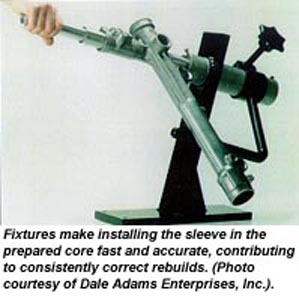
No one can make money long term on low quality
racks that have a high warranty claim rate, so many rebuilders
say there must be a shift in the market away from lower and lower
prices towards a higher level of quality and workmanship. However,
the only way that can happen is to raise prices so there’s enough
margin to keep quality in the product. Unfortunately, many parts
stores and retailers are not willing to raise prices or to pass
along higher costs to their customers because doing so might jeopardize
their competitive advantages in the marketplace.
Several rebuilders said that rack prices to
consumers have not really changed much in recent years, but wholesale
prices have plummeted. So the pressure has been on rebuilders
to take cost out of the product. For some, the easiest way to
do that has been to cut corners by reusing parts that maybe shouldn’t
be reused and not testing racks as thoroughly as they should be
tested. As a result, quality has suffered. In such cases, the
only way quality is going to make a comeback is if prices go the
other way.
An inside perspective
Dale Adams of Dale Adams Enterprises, Kent,
OH, is a supplier of sleeves and equipment for rebuilding racks.
Consequently, his fortunes have followed those of his rebuilder
customers.
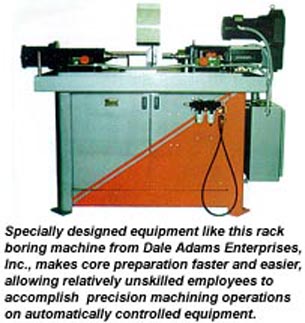
"Two years ago, about a million racks
a year were being sleeved," said Adams. "Today, that
number has dropped to about half-a-million." He attributes
the decline to improvements in the design and longevity of OEM
racks, and less emphasis on rebuilding a high quality rack.
"Back in the 1980s, the "morning
sickness" problems of the early General Motors A and X-car
racks, and Ford Fairmont were really driving this business,"
continued Adams. "But GM solved its rack problems in 1989
to 1990 and the demand has been dropping ever since.
"It used to be rebuilders were selling
replacement racks to owners of cars that were two to four years
old. Today, they’re selling racks for cars that are eight to 10
years old.
"To make matters worse, remanufactured
racks that used to sell for $100 are now going for $40. You can’t
rebuild racks profitably at that price, so it’s no wonder a lot
of rebuilders have gone bankrupt. There are fewer people rebuilding
racks today, but we still have an oversupply of racks in the market.
What we need is a return to prices in the $55 to $60 range to
restore profitability in rebuilding racks," said Adams.
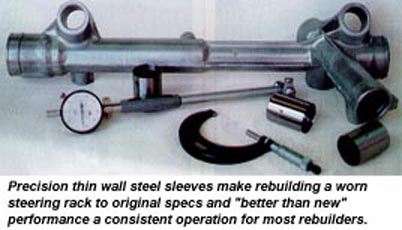
As for his own business, Adams said his company
provides a high quality, low cost sleeve and a unique sleeving
method that "heat shrinks" the sleeve into place. This
approach, he says, is better than pressing a sleeve into place
because pressing can leave voids behind the sleeve that promote
leakage.
"You can have up to 800 psi inside a steering
gear under some circumstances, so if a sleeve is pressed in it
may start to leak as the rack warms up," offered Adams. "Aluminum
expands at twice the rate of steel, so you don’t want any voids
between the sleeve and housing. Using heat shrinking to install
the sleeve and locking compound to hold it securely in place eliminates
the voids and any potential for leakage."
Adams says his boring equipment locates on
the original spool valve bearing area to find the center of the
housing. This results in a more accurate cut and better fit of
the sleeve.
A hot market?
Pablo Aguilera, president of PS Systems, Inc.,
Miami, FL, says his company is selling every rack it can build.
"We started rebuilding racks 14 years ago, and we were one
of the first to do so in the southeastern United States. Over
the years, I’ve seen people get into and out of this business.
Many didn’t know how to rebuild racks properly so they didn’t
last."
Aguilera said that although there’s a lot of
competition (the average installer price for domestic racks in
the Miami market is about $70 versus $100 for import racks), he
thinks prices have bottomed out and that the market is stabilizing.
Bill Hayes of ARC Remanufacturing in Astoria,
NY, also sees "good demand" for rebuilt racks, but says
pricing in his area is "in the garbage can." The WD
price for domestic racks averages $46 to $52, and $90 to $100
for import racks.
"If you had asked me two years ago if
we could sell racks for what they’re selling them for today, I’d
have said you were nuts," explained Hayes. "I thought
prices bottomed out two years ago, but it has only gotten worse.
We have a lot of competitors who are picking the A and B numbers
and killing prices. A lot of these guys are putting out a poor
quality product. Their customers are complaining but the retailers
still won’t pay a decent price for a quality rack. They might
pay you $1 more, but not $10 more," said Hayes.
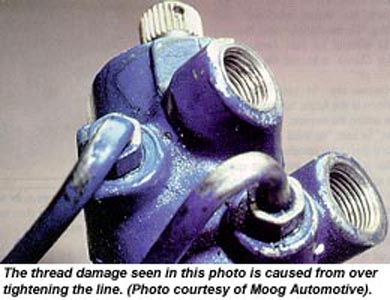
On the West Coast, Mark Zemlicka rack product
manager for ACEI, Buena Park, CA, says the rack business is good
although the overall market has been relatively flat. "We
do about 6,000 racks a month, both import and domestic,"
said Zemlicka. "We build a quality rack with a lifetime warranty.
We do a lot of things other rebuilders, don’t. We use a centerless
grinder to redo shafts. We also replace tie rod ends and have
new nylon inserts installed in the inner sockets to restore tolerances."
Zemlicka said the typical jobber price for
racks in his market is $79 to $89 for domestic units, and $129
to $159 for import racks. He noted that "bucket pricing"
(selling a variety of racks at the same price) is hurting the
industry.
"It takes a lot of labor to rebuild a
rack, a lot more than say a front-wheel drive shaft," said
Zemlicka. "Many of the parts for late model racks can only
be sourced through a car dealer, which adds to the cost. Testing
equipment is expensive, too. This makes it hard to earn a profit
when prices are so low. That’s why a lot of rebuilders are just
buying their racks from somebody else and repackaging them."
Mark Haddox of AAR, Inc., North Ridge, OH,
said the rack market overall is essentially flat. AAR markets
nationally, and prides itself on building high quality units.
"We’ve seen some increase in demand for import racks, particularly
for Nissan Maximas" said Haddox. "On the domestic side,
there’s a lot of demand for Ford Aerostar and Dodge Dakota racks,
but the cores are hard to get."
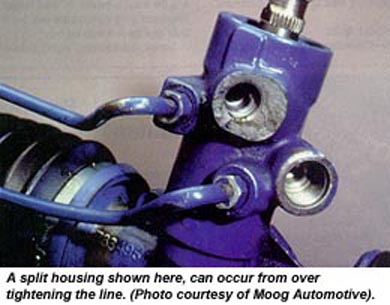
Haddox says he sees fewer rack rebuilders in
the future, but that he plans to be among the survivors. "I’m
not a price cutter," he said. "We build a quality product
and don’t have comebacks. I think the market is starting to appreciate
quality once again, and that price isn’t the driving force it
has been the past couple of years."
Haddox says AAR’s racks come with a lifetime
warranty, plus a unique two-year roadside assistance program that
covers the cost of towing should a vehicle experience a disabling
steering problem. "We haven’t had one claim yet," said
Haddox. "Our customers like the roadside assistance program
because it gives them something extra to offer their customers."
Import racks
Mavel Manufacturing in Twinsburg, OH, is one
of the leading rebuilders of import racks. According to Dale Lumby,
Mavel averages 4,000 to 5,000 racks a month, most of which are
import applications.
"Things are starting to pick up now, and
the worst is behind us," said Lumby. "There was a big
shakeout last year, but it looks as if the rack wars are over."
Lumby said rebuilding import racks is unlike
domestic racks for several reasons. One is the proliferation of
rack numbers. Import manufacturers change rack designs every couple
of years, so there are a lot of different racks, none of which
are produced in numbers anywhere close to their domestic counterparts.
"We might sell a maximum of 200 units a month for the most
popular import number, explained Lumby. "But a major rebuilder
of domestic racks might move 10,000 of a single number in the
same time period."
This means component parts for import racks
are harder to find (often dealer only) and often cost more than
parts and seals for domestic racks. Like most rebuilders, Lumby
was tight-lipped about his sources of supply, but said that Mavel
sources its parts worldwide.
"We have the kind of volume that justifies
tooling up to manufacture the parts we need," said Lumby.
"We also sell parts for import racks to other rebuilders."
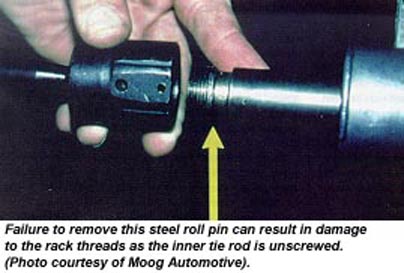
Lumby warned that the quality of component
parts, particularly seals, varies greatly from one source to another
so rebuilders should always monitor quality closely. Lumby also
said import cores are also more costly, some going as high as
$200. Most units, however, are about $100 compared to $50 or less
for a typical domestic.
"The biggest problem with import cores
is getting the right ones," said Lumby. "Unless you’re
willing to travel around the country and hand pick what you want,
which we do, you can end up with a mountain of cores you’ll never
be able to move if you just ask a core broker to ship you all
his import cores."
Many import racks have variable steering assist
with electrical controls. Lumby said some rebuilders skirt the
issue by selling reman racks without a solenoid. "But telling
the installer to reuse the old solenoid is asking for trouble,"
said Lumby. "So we sell our racks complete with the solenoid.
This complicates our testing procedure because we have to test
the rack for the proper assist at various speeds. But the extra
testing assures us of a better product that won’t come back."
Lumby said Mavel has achieved QS-9000 quality
certification, a standard which is necessary to be an OEM supplier
these days. "We spend 12 to 15 minutes testing every unit
we rebuild. We feel this is absolutely necessary to maintain the
highest level of quality. We could probably drop some of the testing
and still have the same quality, but we’ve built our reputation
on quality so we’re not about to do anything that would undermine
that reputation."
Lumby said his company is constantly testing
and evaluating racks built by competitors. He said they recently
purchased six racks from a well-known national rebuilder for some
newer applications with variable assist power steering. "We
found that three of the six racks failed our quality control tests.
Whether the average consumer would have noticed the difference
or not may be debatable, but according to our tests the racks
did not perform properly."
South of the border
In Reynosa, Mexico, just south of the Texas
border, TRW operates a large rack rebuilding facility. The facility
is owned by TRW and supplies a number of companies in the U.S.
including Federal-Mogul, Chrysler, Nissan and Hyundai.
A company spokesman said that TRW "remanufactures"
rather than rebuilds racks. Everything is built to OEM standards.
All elastomers (seals and bellows) are replaced with new. Racks
are magnafluxed to test for flaws and cracks, something which
TRW believes is necessary for a safety-related component, but
that many rebuilders fail to do.
Rack housings are bead blasted to stress-relieve
the metal and to remove all rust and corrosion prior to reassembly.
Many rebuilders, says TRW, simply paint the rack housing to hide
imperfections and flaws. TRW housings are precision bored and
steel sleeves are press fit and chemically bonded to restore tolerances.
TRW tests every rack after it has been assembled
to make sure it meets all OEM specifications. Mesh tests are
conducted to ensure compatibility of the internal gears. Pressure
tests measure torque at the input shaft to determine whether the
proper steering assist and balance are available. High-pressure
tests check for internal leakage around seals. Following these
tests, each rack is then assigned an individual serial number
and the unit’s test data is stored for warranty reference.
Cores
As the rack market goes, so goes the core market.
Bob Grady of Rebuilders Automotive Supply in Cranston, RI, says
rack sales have been "inconsistent." Grady says the
demand for import racks has been "fair" but the demand
for domestic racks is down. He said 1988-í91 Ford Taurus,
Ford Aerostar, Dodge Dakota, Chevy Lumina and 1984-í88
Dodge Caravans were the domestic racks in most demand.
On the import side, Grady noted that 1985-í88
Toyota Maximas and some of the later Honda and Acura racks are
moving well. "There’s virtually no market for Mitsubishi,
and the late stuff is hard to identify," said Grady. "As
for the European racks, the demand for BMWs is okay, but we hardly
ever sell a core for an Audi."
Grady said his company has seen the most growth
in import cores. "Three years ago we hardly sold any,"
Grady explained. "Today we’re selling import racks by the
trailer load."
The next generation racks
To date, only Toyota’s MR2 sports car and GM’s
EV1 electric car have electro-hydraulic racks. Both racks use
hydraulics for power assist, but on both applications the conventional
engine-driven power steering pump has been replaced with an electric
motor. This saves energy, simplifies the steering gear and makes
for a more compact steering gear assembly.
In the case of the MR2, this approach eliminates
the need for plumbing connections between the engine in the rear
and the steering gear up front. On GM’s EV1 electric car, it eliminates
any extra load on the electric drive motor which would reduce
the car’s normal driving range.
Back in the mid-1980s, TRW unveiled an electric
power rack-and-pinion steering system dubbed "Powertronic."
Engineers recognized the advantages that electric power steering
could provide compared to conventional hydraulic power steering.
Since an electric powered system doesn’t need an hydraulic pump
or plumbing, it’s an ideal choice for mid-engine or rear-engine
vehicles.
An electric powered system also reduces the
parasitic horsepower drain on the engine up to 80% by eliminating
the power steering pump. Power is provided through the alternator,
but only on demand. A conventional power steering pump, on the
other hand, pumps fluid continuously whether it is needed or not.
So the change from hydraulic to electric power can reduce fuel
consumption up to half a mile per gallon depending on the application.
The high cost of the Powertronic unit compared
to conventional hydraulic steering doomed the novel steering gear.
It never went into production. It was shelved, however, research
and development continued.
Today, engineers are again considering the
advantages of electric steering with electronic control. These
advantages include:
- More compact assembly which simplifies
installation on the assembly line; - No hydraulic seals or lines to leak;
- Quieter operation;
- Lower energy consumption; and
- The ability to vary steering feel and effort
electronically, which means almost unlimited adjustability.
The only fully electronic rack currently n
production is that on the limited production Acura NSX sports
car, though several European manufacturers and Cadillac are reportedly
considering fully electronic steering applications for the model
year 2000.
The NSX system consists of a rack-and-pinion
steering gear with an electric motor installed concentrically
around the rack. The motor transmits its power through a recirculating
ball drive mechanism to push the rack right or left.
A "steering sensor" is located on
the input shaft where it enters the gearbox housing. The steering
sensor is actually two sensors in one: a "torque sensor"
that converts steering torque input and its direction into voltage
signals, and a "rotation sensor" that converts the rotation
speed and direction into voltage signals. An "interface"
circuit that shares the same housing converts the signals from
the torque sensor and rotation sensor into signals the control
electronics can process.
Inputs from the steering sensor are digested
by a microprocessor control unit that also monitors input from
the vehicle’s speed sensor. The sensor inputs are then compared
to determine how much power assist is required according to a
preprogrammed "force map" in the control unit’s memory.
The control unit then sends out the appropriate command to the
"power unit" which then supplies the electric motor
with current. The motor pushes the rack to the right or left depending
on which way the voltage flows (reversing the current reverses
the direction the motor spins). Increasing the current to the
motor increases the amount of power assist.
The system has three operating modes: a "normal"
control mode in which left or right power assist is provided in
response to input from the steering torque and rotation sensor’s
inputs; a "return" control mode which is used to assist
steering return after completing a turn; and a "damper"
control mode that changes with vehicle speed to improve road feel
and dampen kickback.
If the steering wheel is turned and held in
the full-lock position and steering assist reaches a maximum,
the control unit reduces current to the electric motor to prevent
an overload situation that might damage the motor. The control
unit is also designed to protect the motor against voltage surges
from a faulty alternator or charging problem.
The NSX electronic steering control unit is
capable of self-diagnosing faults by monitoring the system’s inputs
and outputs, and the driving current of the electric motor. If
a problem occurs, the control unit turns the system off by actuating
a fail-safe relay in the power unit. This eliminates all power
assist, causing the system to revert back to manual steering.
A dash EPS warning light is also illuminated to alert the driver.
To diagnose the problem, a technician jumps the terminals on the
service check connector and reads out the trouble codes.













